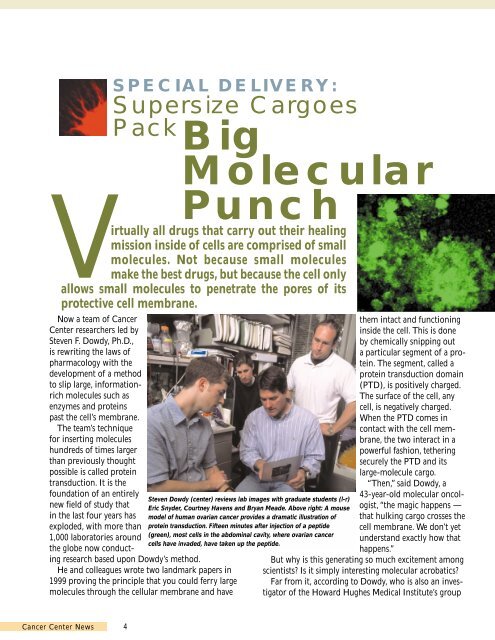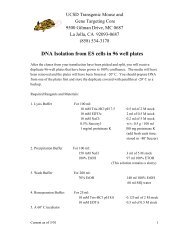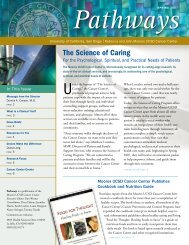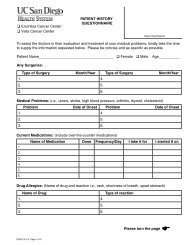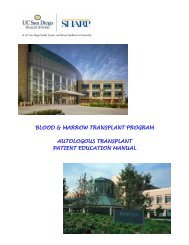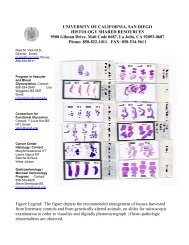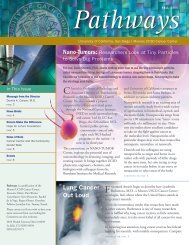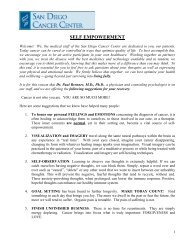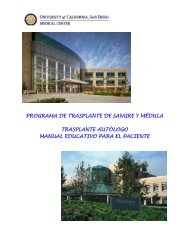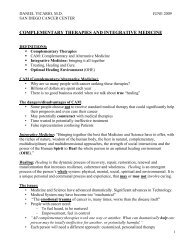PROTEIN TRANSDUCTION: - Moores Cancer Center
PROTEIN TRANSDUCTION: - Moores Cancer Center
PROTEIN TRANSDUCTION: - Moores Cancer Center
You also want an ePaper? Increase the reach of your titles
YUMPU automatically turns print PDFs into web optimized ePapers that Google loves.
SPECIAL DELIVERY:<br />
Supersize Cargoes<br />
Pack<br />
Big<br />
Molecular<br />
V<br />
Punch<br />
irtually all drugs that carry out their healing<br />
mission inside of cells are comprised of small<br />
molecules. Not because small molecules<br />
make the best drugs, but because the cell only<br />
allows small molecules to penetrate the pores of its<br />
protective cell membrane.<br />
Now a team of <strong>Cancer</strong><br />
<strong>Center</strong> researchers led by<br />
Steven F. Dowdy, Ph.D.,<br />
is rewriting the laws of<br />
pharmacology with the<br />
development of a method<br />
to slip large, informationrich<br />
molecules such as<br />
enzymes and proteins<br />
past the cell’s membrane.<br />
The team’s technique<br />
for inserting molecules<br />
hundreds of times larger<br />
than previously thought<br />
possible is called protein<br />
transduction. It is the<br />
foundation of an entirely<br />
new field of study that<br />
in the last four years has<br />
exploded, with more than<br />
1,000 laboratories around<br />
the globe now conducting<br />
research based upon Dowdy’s method.<br />
He and colleagues wrote two landmark papers in<br />
1999 proving the principle that you could ferry large<br />
molecules through the cellular membrane and have<br />
Steven Dowdy (center) reviews lab images with graduate students (l-r)<br />
Eric Snyder, Courtney Havens and Bryan Meade. Above right: A mouse<br />
model of human ovarian cancer provides a dramatic illustration of<br />
protein transduction. Fifteen minutes after injection of a peptide<br />
(green), most cells in the abdominal cavity, where ovarian cancer<br />
cells have invaded, have taken up the peptide.<br />
them intact and functioning<br />
inside the cell. This is done<br />
by chemically snipping out<br />
a particular segment of a protein.<br />
The segment, called a<br />
protein transduction domain<br />
(PTD), is positively charged.<br />
The surface of the cell, any<br />
cell, is negatively charged.<br />
When the PTD comes in<br />
contact with the cell membrane,<br />
the two interact in a<br />
powerful fashion, tethering<br />
securely the PTD and its<br />
large-molecule cargo.<br />
“Then,” said Dowdy, a<br />
43-year-old molecular oncologist,<br />
“the magic happens —<br />
that hulking cargo crosses the<br />
cell membrane. We don’t yet<br />
understand exactly how that<br />
happens.”<br />
But why is this generating so much excitement among<br />
scientists Is it simply interesting molecular acrobatics<br />
Far from it, according to Dowdy, who is also an investigator<br />
of the Howard Hughes Medical Institute’s group<br />
<strong>Cancer</strong> <strong>Center</strong> News<br />
4


